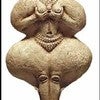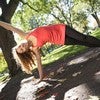Description
About This Video
Transcript
Read Full Transcript
Okay. So let's begin to go to the mat. And Way we do this is we're going to use the same roll down as we did in the, in the previous piece. So or in any piece where we're going to move and articulate through the spine. So arms reach up, overhead arms stay alongside the ears and then rounding over head, neck, shoulders and arms, using the intercostals to pull a wraparound pull in and up on your lower belly. And then Ronnie over into the lumbar and then rounding over all the way fingertips to the floor, touching Relevate roll to the balls of the feet, bend your knees, walk yourself out and come into what I call a diamond cit or a seal if you want to call it that. So we're sitting in this position, the diamond is twice as long as it is wide. So we're reaching out with, Huh? It's twice as long as it is.
Why we could take our straps and use it as a measure. And yeah, we were talking about that today. I had no idea that I would be teaching so much arithmetic. I'll say two more. And someone will add another one. So that would be three, two plus, one more as a three rather than two. So here we are, and Lincoln ups and you, from your navel to your pubis, you pull in. So nothing is moving backwards yet you're keeping the chest and back open. Reach your fingertips out as if you're holding a hula hoop or a ball and sharp your pubis forward. Roll off your sits bones. Roll onto them.
Roll off, head up, eyes up and forward. Two more times. One more time. This time, set up on the sits bones. Roll back onto your sacrum. Get onto the sacrum and then roll up off the sacrum onto this sitz bones. So keep your eyes level. Christy, use this cue and one of the classes she taught I staying forward.
And so your eyes stay looking out and you'll, you'll learn to position your head with more ease I think. So here and onto your sacrum and then up onto your sits bones two more times onto your sacrum, onto your sits bones. One more time and onto your sits bones. So I want to be doing is opening up the lower back. So now we're going to go from the sacrum, top of the sacrum to the lowest rib. So we're here sacred first, second breath onto the lowest rib, and then rolling up onto the sacrum, back of the pelvis, then the lowest rib, very good. And then rolling up to more of those. Keep the elbows up, shoulders down, widen the back, widen the space between the shoulder blades, lowest rib and coming up.
Last one of these. So we're through the spine into the lowest rib and then coming up this time, three breasts to get down and [inaudible] sacrum, lowest rib tips of the shoulder blades and rolling up. I'm going to watch and say crumb.
So what I'm saying is if we go here now, we're opening up all of this area here and this is allowing that to open even more. So we want more space between the Vertebra. There's a lot of people having lumbar surgery recently and that's in that they're not opening the back, they're not opening. So we wanna open on the way down and unroll onto the vertebra of the back of the Vertebra. So let's do that please. And sacrum, lowest rib tips of the shoulder blade. Yes. And rolling up all the way to upright sit. Let's just sternum, shoulder blades down and wide. And tips of the shoulder blades and rolling up. Shh. One more time. And lowest rib tips of the shoulder blades and rolling up. Good.
So this is what we'll do next. What happens? It's here's, there's a tendency to tip the on Fa. So as connection with a femur tipping the tailbone up right here, grabbing on. We want to lengthen that down and get more of a stretch into the lower back. So when we rolled down this time, we're going to pulse. The pulse comes from the sits bones. And the pubis reaching to the heels.
So we're stretching the lower back down. Let me see that. So what's happening? No, no. What's happening is we want to lay down. So if I'm in diamond and I'm in the contraction, I want to do this, this, I'm not doing that. And not going from a tilt to a linkedin spine. We want to stimulate the so as to learn how to release. Yeah. Posterior poster. Exactly. Cause we're stretching this down.
It goes into the classic model of getting the lower back, lengthened a eve gentry saying that we want to imprint the spine. So let's do that. Yeah. For it takes a little while. This is a coordination skill to be able to drop that down because it's so as if for some of us tends to want to tighten up and go this way. We want to not do that. All right, so rolling down sacrum.
That makes it tough. And that's a good thing. So we start to integrate the strengthening competitive capacity of the lower back. Let's do it again one more time because I know where we're going next. Now rolling down sacred lowest rib tips of the shoulder blades and the pubis. Very good. Eight more. Yeah. H Four three two and rolling up.
Yeah, to upright sit. I went on a campaign about eight years ago. It wasn't about eight years ago on community where I said we no longer want to be a slave to our, so as in habit, tighten up and not know how to lengthen. So this teaches us to befriend it. The so as from the lower back to the front of the femur. Take your straps.
I'm going to do a classic neck pole. This is what I like to do with the strap. So you take two, two and you put the strap at the back of the base of the skull, the hospit bone, and let the strap go over the ears. So you're holding the strap here, you're going to lengthen up. Same three breasts, sacrum, lowest rib, the tips of the shoulder blades and a roll up. So that's the articulation, allowing the head to reach and float up. So keep the crown of the head upright. Yeah. And let me see it. And roll down sacrum.
Lowest rib tips of the shoulder blades and rolling up crown of the head reaches up, up, up. Yeah. Huh. Yup. Yup. It's a class. It feels very classic once you start to understand it. Huh? Crown. Yeah. What's interesting though, what you bring up is the two things that I'm watching for. See, I'm looking for the energetic of the eyes when I teach. So when I see your eyes clear, then I know you're at the third eye here and I also know that the crown of the head is reaching up. It's something that I've learned in my teaching, and that's a good thing to notice that those in relationship allow us to look out. It keeps us out of the tension of our neck and shoulders. Let's go again one more time and keep the elbows forward.
So you're widening your back and onto your lowest rib tips of the shoulder blades. So you're looking past, let's do the pulses with the sits bones. And very good. Four, three, two and roll up Candice skid. That's it. That's what it is. Very good. Yeah. So I could not do a classic neck pole very well at all until I started to understand it through the mech mechanism of this. And as I always suggest, the prop is not what we want to learn. We want to learn from the prop. So we want to learn how to use our body. The prop then can fall away and we can do a neck pole.
So I'll show you how bad my neck pole is after we do this. Yeah. Cause I just, I could not do a neck poll forever. Men have a tougher time with neck pokers we're heavy up here. Women are more grounded in the pelvis. So let's play with this. What I want to do is this, this is the pattern now with the breath
One more time and hinge. She rolled down to the tips of your shoulder are very good. Yes. Roll up crown of the head towards your toes. Flex your feet, fight for the back of your body. You have to struggle a little bit until you turn it on. Then roll up to upright. Sit. Shed. So now what I want to play with is, is the um, the evolution into teaser. So let's play with it this way. It'll, you'll roll down your roll down.
Let's do a roll down for now and do a teaser here and then roll down. So we're stimulating the, so as the lower back connection here. Also getting into the QL from the bottom of the rib cage to the top of the pelvis. So let's go with that. So rolling down now. Then we're going to add that into what we do with the the neck pole and flex your feet roll up into a hinge. So your back slat hinge, look out, look out, look out, and then roll down to the tips of your shoulder. [inaudible] yeah, flex your feet and then hinge. You gonna do this three more times. Hanshin Shan's flat back, flat back.
And then roll down to the tips of your shoulder blade. Yes. And flex your feet and hinge. Flex your feet, him flat back, flat back. And then roll down to the tips of your shoulder blade. Age last time and flat back. Tips of the shoulder blades roll down
So let's go ahead and now with the out the strap, the neck pole. So you were talking about this, the committing of the lacing of the fingers. So let's go with this. So now we're doing the same pattern but without the strap. Now we have to integrate our backs more if we don't have the prop pulling us wide.
So we have to open that with our own new own initiative within the muscle. So lengthen up and hinge and contract
So until I use the strap to prop it, I couldn't do that. Makes sense to me.
The heel lead is a crucial way of understanding. Most people step on the ball of their foot and we want to turn that off by getting this ball of the foot is fine. We don't want to make that our habit. We want to learn to lengthen the back of the leg. So, so someone stepping this way is going to have a stronger step and somebody always stepping this way. Yeah. So let's play with that one more time. Neck pole and hinge.
It's like the attorney off the back of your body. When the elbows come forward, you tend to collapse into the spine rather than Lincoln out of the spine.
So you're holding this position here. All I know is that when I do this I get very stimulated in these muscles here, the outer thighs up into the quads. I just get turned on. It's obviously not something I don't do enough. Yeah. And lift the sternum shoulder blades down. Okay. So now we'll go into that. Roll down a three breath. Let's make it four breaths.
So the fourth breath will be neck and head. So like then up and roll down onto the sacrum. Flex your feet onto the lowest rib, flex your feet under the tips of the shoulder blades, the neck and the head. Keep your shoulder blades wide. Then the head comes up, shoulder blades wide and roll up to upright. Sit. Keep Flexing your feet to upright sips.
And now what you're doing is you're allowing the shoulder girdle to stabilize. Yeah. While you're moving through the lower back into the thoracic, neck and head. So linkedin up and roll down sacred.
And then roll up head general up off the mat. Shoulderblades gent. Excellent. Excellent. Yes, yes. And lift the front of the spy. Everyone tells me this is easy. It's easy cause it's turned on. I mean it's a lot of work, but that sense of, oh it's that. Yeah. Yeah. Two more times. And
And then head up shoulder blades down. And why do yes. And then roll up. Flex your feet. Yeah. Pull through the back of the legs. Reach to the heels. Nice to upright. Sit. Very good. One more time. Rolling down. Say from lowest rib tips of the shoulder blades. You're rolling through it. Very good. And then neck and head.
Cause you have that sense of lengthening out the reaching out. What I've learned is that in, in my years of personal training, getting a thick, cause I'll get very thick, very fast, is that I don't want that anymore. I want that reaching out. I want the connected tissue to be longer. I'm back into rolfing and that's what's starting to happen. The muscles getting longer again. So it's a strong Mack, in fact, maybe even stronger. So let's play with this one more time.
We're going down now. Let's go into the diamond. This becomes the pattern. So the second breath, we're straightening the legs. First breath back of the sacrum. Second breath, lengthen the legs to parallel anchor bones touch and then roll up. Exhale to diamond. So that's the cycle. And then we're going to play with it.
Entities there and roll down sacred. Shh. Extend the legs out. Shifts to the shoulder blades roll up. That's the inhale. Exhale to diamond, right? What's fun about this? Actually, that's very much like Fletcher work. What you just did. Fletcher work is round.
So you want to play with that a little bit? Sure. Alright, so to make that more Fletcher, ask Ron Fletcher work is, we'll round down, we'll go here, you come up and over and then we can go ahead and play with this. We can hinge it. See this is what I love to do. Now it evolves and then we come back to center. All right, that's the pattern. All right, so here we go. Lengthen up and onto your sacred. Lengthen out parallel tips of the shoulder blades. And let's roll up.
Open to diamond, round over, and then reach out. Flex your feet, reach out. There's the hand slap back. We flex our feet. There was that association come up to upright and arms open. Let's do it again two more times and I'm going to add something else round down. Say crumb, extend the leg, sips of the shoulder blades. Roll up and oh pen.
Grow the hinge upright and open chest. Yes. And last time legs extend. Roll up and open. We're playing with coordination. Skill. Flex the feet to grow the hand. She come up and let's rest that. That's great cause you give an opposition for every everything. Yes.
That's her there. Then when we go deeper here, you're reaching further there. And that feeling is what I crave. Now. I no longer want to have this happen in my body. It's this into my performance skills right now, going aerial, leaving the ground. I have to be aware of that. Or I get stuck and get caught in the apparatus harnesses and ropes.
So it's fascinating stuff. So what I want to play with one more time to just play two right to end it, this piece of it. So we'll roll down here.
Would be a great finish, Huh? Que the first one. We're here
You can open the teaser to a hinge or flat back, then come up to sit and open. Yeah, let's see it one more time. Yeah, one more time and rolling down. Shh. Bring the legs up. Roll into the teaser. Good work and parallel leg. Extend the legs. Shh. Find your arm position.
You can extend the teaser or stay contracted. That's your choice. And then roll up to sit and diamond. I love that. The growth of that, that potential to get stronger in the spine. And that's all the forward mechanics, extension mechanics. All right, so go and take your legs out to the side. Roll onto one hip and bring your legs underneath your thighs. Do a little standing in centering work. Roll to the balls of the feet.
And I particularly like this stretch here. Get your feet flat on the floor. Drop your hips. Let the crown of your head round towards your toes. So you're routed there. Let your arms fall down. Drop your hips, lift your belly and your intercostal so your fingertips do not touch the floor. So you want to be suspended very much like a downhill skier or a racer that kind of Tuck. Yes. So we're doing is, we've used the lower back tremendously tonight, so we want to be able to open the back of the back arms, hang down, crowded of the head, hangs down, tip of the tailbone hangs down and from the knees. Now you'll Paul Sand
And four three to straighten the legs hits. Go Up, head down. Yes. And then roll up pelvis and sacrum. Then lumbar and lower back, thoracic and ribcage. Neck and head. Peel your maths off the floor. So we have the open bearwood.
I like this piece. This looks very much like bar work. If someone has studied ballet or even modern at the bar, we are in turnout because it allows us to open the hips a little bit more. You can, Huh? Nope, no more straps. So we can get rid of it. So what the pattern is to reach out and to bend your knee and then come back to center. So this is a balance and centering, a balance and centering. So the leg is to stay straight. This is a different operation to step.
So you want to lift, reach and place, lift, reach and return. Yeah. So we're finding that sense of of a center and balance through the spine. We can do it with the arms out here or you can do it with the hands here. Wherever you feel more confident even this is fine. So the point is for you to feel anchored because what this is about is coming back to center. Yeah. And
Gather one more time. Suspension, fall suspension, gather fall and gather. We were building a Ronda Shama circle of the hip. We go forward, we go side, we come in center. So we're a little bit better balance here and
So what I'd like to see as you step out and around you step out and around. So you're using the, the um, BD Alice, Rudy's meet the media, the medias and the Gluteus maximus. Yeah. So we're here, make a circle with the leg a circle. So it's like the leg circles that we would do.
You want to sense that the head floating back. The more we widen our shoulder blades, the more we can stand with our head in place. We don't have to work so hard. As soon as the shoulder blades go back, we'll tend to come forward with the head. So widening there and
Comments
You need to be a subscriber to post a comment.
Please Log In or Create an Account to start your free trial.













